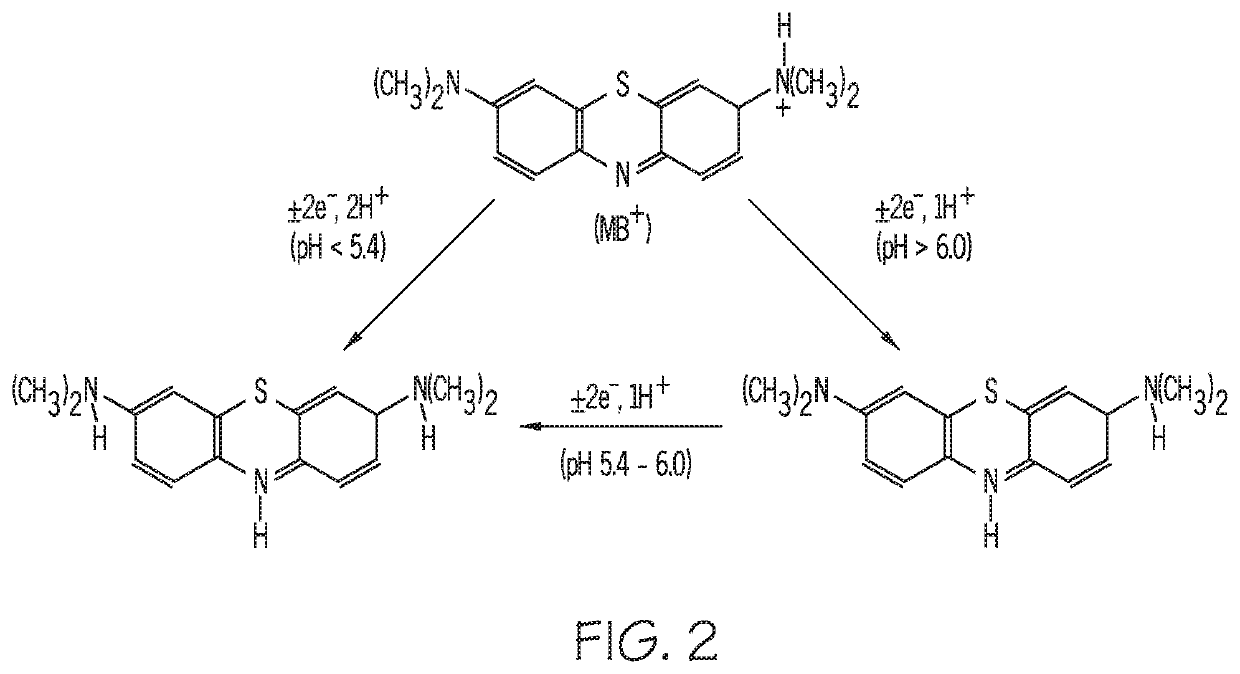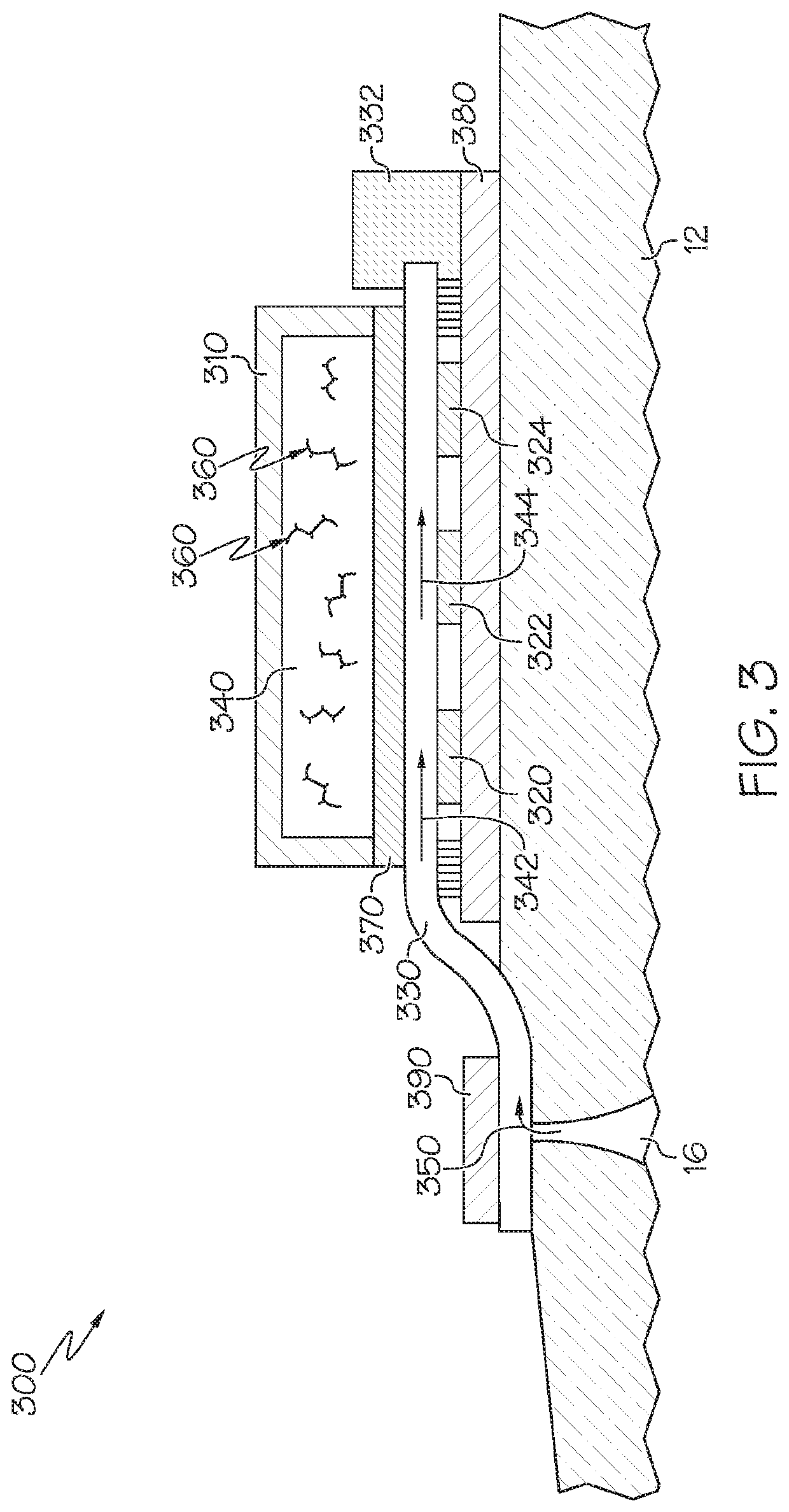Biofluid sensing devices with ph-buffered eab sensors
a biofluid sensor and eab technology, which is applied in the field of biofluid sensing devices with ph-buffered eab sensors, can solve the problems of low sample volume, limited recent progress to high concentration analytes (m to mm), and reduce or eliminate signal changes, improve the accuracy of biofluid sensors, and reduce the effect of signal chang
- Summary
- Abstract
- Description
- Claims
- Application Information
AI Technical Summary
Benefits of technology
Problems solved by technology
Method used
Image
Examples
first embodiment
[0040]Referring now to FIG. 3, which illustrates a biofluid sensing device 300 shown on a section of skin 12. The device 300 includes at least one analyte-specific sensor (three sensors 320, 322, 324 are shown in the illustrated embodiment). The device further includes a polymer substrate 380 made of PET, or other suitable material, on the skin surface 12. A microfluidic channel 330 contacts the skin surface, or is in fluid communication with the skin surface through a sweat collector, for accruing one or more sweat and / or other biofluid samples, indicated by arrow 350, as the sample emerges from a gland 16. The biofluid sample is conveyed through the channel 330, as indicated by the arrows 342, 344, past sensors 320, 322, 324, and onto a sample pump 332. The sample can be conveyed through channel 330 by any suitable mechanism for transport, including osmosis or wicking pressures. The microfluidic channel 330 may comprise a closed channel, an open channel, a tubular passage which ma...
second embodiment
[0043]In a second embodiment, depicted in FIG. 5, a sensing device 500 includes a buffering material 540 in an immobilized condition. In this embodiment, the buffering material includes one or more selected polymers 560 chemically fixed on a surface within a reservoir 510. The polymer molecules 560 may be affixed by covalent bond, or other suitable method known in the art. Bonding the polymer chains to an inner surface of the reservoir 510 allows greater flexibility to increase the pore size in a membrane 570. The fixed state of the polymer molecules 560 within the reservoir 510 allows the sample to react with the polymer while preventing molecules from moving through the larger-sized membrane pores to contaminate the sample. For certain applications, the larger membrane pore size also allows for a relatively quicker ion exchange between the sample and buffer polymer.
third embodiment
[0044]In a third embodiment, depicted in FIG. 6, a sensing device 600 includes buffering material 640 localized to individual EAB sensors (three sensors 620, 622, 624 are shown in the illustrated embodiment), in order to vary the pH environment of the individual sensors. The one or more polymers in buffering material 640 are selected to tune the sample pH to a preferred, operative pH for the aptamer sensing elements of the individual sensor. A polymer is solvent cast onto each individual sensor 620, 622, 624 to surround the aptamer sensing elements in buffering material. As a biofluid sample moves through channel 330, a portion of the sample will diffuse through the buffering material 640, as indicated by arrows 642, before interacting with the individual sensors 620, 622, 624. As the sample diffuses through the buffering material 640, the sample is protonated or deprotonated, as described above, to achieve substantial equivalence of pH between the sample and the buffering material....
PUM
| Property | Measurement | Unit |
|---|---|---|
| concentration | aaaaa | aaaaa |
| pH | aaaaa | aaaaa |
| selectively permeable | aaaaa | aaaaa |
Abstract
Description
Claims
Application Information
 Login to View More
Login to View More - R&D
- Intellectual Property
- Life Sciences
- Materials
- Tech Scout
- Unparalleled Data Quality
- Higher Quality Content
- 60% Fewer Hallucinations
Browse by: Latest US Patents, China's latest patents, Technical Efficacy Thesaurus, Application Domain, Technology Topic, Popular Technical Reports.
© 2025 PatSnap. All rights reserved.Legal|Privacy policy|Modern Slavery Act Transparency Statement|Sitemap|About US| Contact US: help@patsnap.com



